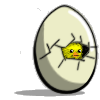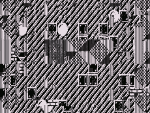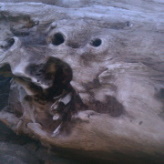|
Hasselblad posted:The latter. Planning to connect the edges via a massive tongue/groove. Finished depth around 24" (minus what needs to be jointed/planed/T&Ged) I've had them a few years and they are as dry as they are going to get, so I am not overly concerned about any warping beyond what they are currently. Otherwise I would use stacked 2x4s. You really don't need to T&G them, imo. If they're that out of synch, the tongue is liable to split off anyway as you're trying to make the joint close. I'd use a 2 lb deadblow hammer & judicious clampery.
|
|
|
|

|
| # ? May 30, 2024 02:48 |
|
Today's woodworking accomplishments: snapped in half the dust collection hood for my router (a little piece of plastic that costs 40 loving dollars), then scraped a knuckle and sheared off the depth setting rod on the plunge router base while removing the router bit so I could remove the hood to try to glue it back together again. I bodged together a new depth setting rod out of some scrap maple (and honestly could probably replace it with any rando .25" metal rod, it's nothing fancy), but the hood may not be recoverable. On the plus side, the mortises I've been cutting are accurately-placed and a good fit for the tenons. This piece is going to be pretty solid once it's done.
|
|
|
|
go for a stroll posted:"these boards are just too big for a #7 plane", i think to myself never Planing is not an issue if you are content with warped wood that is equal thickness. 
|
|
|
|
Kaiser Schnitzel posted:If you have a bench top planer you can just flatten the two wide sides and rip off the unsquare edges with a table saw. Stuff that thick is probably fairly straight and shouldn’t really need face joining. Plane the convex side flat, flip it over and do the concave side. The large surface is noticeably not-flat. Mr. Mambold posted:You really don't need to T&G them, imo. If they're that out of synch, the tongue is liable to split off anyway as you're trying to make the joint close. I'd use a 2 lb deadblow hammer & judicious clampery. If not a T&G then it will be pegged at the very least. Either way I want to spend the little extra to have it all squared up prior to getting to that step. Will likely have a couple of these squared up nicely for comically large legs for the bench:  Bonus photo of our local air quality:  (That's a forest fire in case the subject matter wasn't clear. Pun intended) Hasselblad fucked around with this message at 22:07 on Sep 15, 2018 |
|
|
|
Hasselblad posted:The large surface is noticeably not-flat. On that thick of stuff your planer can make it flat across the width. If it is badly crooked/not straight along the length, you can get it fairly straight fairly quickly with a big hand plane taking an aggressive cut on the high spots, and the planer will get it flat enough to make a bench top. Biscuits or dowels would probably be better/easier than a big tongue and groove-that would be hard to really get perfect on such heavy stuff and so you’d actually be losing glue area in the tongue/groove.
|
|
|
|
We were talking about shellac the other day. I'm actually using it for the first time for my current project. I'm using amber shellac flakes with Mike Pekovich's technique. It basically boils down to maintaining a saturated mixture in one jar and diluting that down to a usable mixture in another jar, roughly 1 part shellac to 4 parts alcohol. I had good results with my first batch, but I could tell as I was applying it that my second batch was too thick. Sure enough, after drying it left some "splotches" of darker color where the finish failed to self-level. It's useful to see that failure. It tells me that my first batch wasn't too light, and that my instincts when applying were correct. Nearly done with the carcase construction. Going to go buy some black pipe to use for clamps this morning. After assembly comes applying the back and then it's on to building the doors. 
|
|
|
|
I got rid of my hybrid/cabinet table saw because it was huge and I really didn't need something that big. I'd like to replace it with a contractor size saw, I'm thinking the Dewalt ones you see at Lowes/Home depot are fine? Just want to accurate ripcuts, cross cut jig, I do have a dado blade set. But I'm doing smaller projects with solid wood not 8 foot behemoth sheet good builds. Any opinions ?
|
|
|
|
The DeWalt jobsite saws are excellent. Definitely the best in the price range. There are a couple different models, but it's just rip capacity and mobile base differences.
|
|
|
|
Sylink posted:I got rid of my hybrid/cabinet table saw because it was huge and I really didn't need something that big. I think you may have been better off with the old table saw. What HP was it? Personally would rather have too much tool than suffer with something underpowered. Especially if doing dadoes. Not to mention you will have more clean up to do with a contractor saw spewing dust everywhere, rather than a table you can hook to a shop vac.
|
|
|
|
I didn't have space for the big saw, really. It was really nice to have though, was 2HP and I had a cheap contractor saw before and definitely could tell the difference in power.
|
|
|
|
TooMuchAbstraction posted:I bodged together a new depth setting rod out of some scrap maple (and honestly could probably replace it with any rando .25" metal rod, it's nothing fancy), but the hood may not be recoverable. I've always found that CA glue doesn't hold well on plastic, especially if it's going to be stressed. You'd be better off using plastic cement or a plastic epoxy. If you can figure out what kind of plastic it's made of, you can get a much more accurate idea of what glue to use. The clear parts of that are probably polystyrene, the black bit could be the same, or could be ABS.
|
|
|
|
MaliciousOnion posted:I've always found that CA glue doesn't hold well on plastic, especially if it's going to be stressed. You'd be better off using plastic cement or a plastic epoxy. If you can figure out what kind of plastic it's made of, you can get a much more accurate idea of what glue to use. The clear parts of that are probably polystyrene, the black bit could be the same, or could be ABS. The cyanoacrylate slightly dissolves the plastic, so it should be welded together. Problem is it's impossible to clamp or otherwise ensure that there's a clean gluing surface, because the pieces are so irregular. One of the pieces that came off was for a screw and I've just given up on that bit; I hope a single screw (plus the piece being designed to fit the router base) is sufficient to hold it in place. I did put some epoxy on either side of the glue line after the CA had set up. Who knows if it'll provide any significant amount of strength though.
|
|
|
|
Made another bentwood ring, this one with an inlay. The HDPE rod on a pen mandrel helped a ton with both the CA finishing and the turning, thanks for the tip Parts Kit. I also started to use a cutting board for wrapping/gluing the wood which helped with side seepage of the glue and not sticking. 
|
|
|
|
Hasselblad posted:I think you may have been better off with the old table saw. What HP was it? Personally would rather have too much tool than suffer with something underpowered. Especially if doing dadoes. Not to mention you will have more clean up to do with a contractor saw spewing dust everywhere, rather than a table you can hook to a shop vac. My dewy jobsite saw has a dust collection port underneath and a second one on the blade guard that I could theoretically use if I ever had the blade guard on
|
|
|
|
JEEVES420 posted:Made another bentwood ring, this one with an inlay. The HDPE rod on a pen mandrel helped a ton with both the CA finishing and the turning, thanks for the tip Parts Kit. I also started to use a cutting board for wrapping/gluing the wood which helped with side seepage of the glue and not sticking.
|
|
|
|
So I realized a dangerous oversight on my bookcase plan. I am making 8 foot high by 1 foot deep verticals, and the widest bookcase is going to be 4 foot wide, all made with 3/4 inch ply. My original plan was to screw the shelves into the verticals from the outside, but I think this could be dangerous as the shelves could split like an Oreo, causing the shelves to fail. I don't have a router and I don't have a table saw; I'm planning on getting a miter saw soon. What are my options for joining the shelves to the verticals? I'm planning on 24 total shelves and I'm an amateur, so to me a ton of dados looks daunting.
|
|
|
|
TooMuchAbstraction posted:I did put some epoxy on either side of the glue line after the CA had set up. Who knows if it'll provide any significant amount of strength though. It snapped in half as soon as I put the tiniest amount of stress on it. So gently caress it, I made a new one!  And it works! ...with one eentsy little flaw. There's a reason the commercial version is made out of clear plastic. I can't see poo poo. I'm pretty sure I have some flat clear plastic sheet around here somewhere (and if not, it's definitely available at hardware stores), so in theory all I need to do to fix this is cut off the plywood around the router bit and replace it with that. Still, annoying to spend a few hours in the shop designing and building a thing and have it actually function except for that one problem that renders it totally useless. The hardest part of this, otherwise, was figuring out how to mount the hose fitting. I don't have anything that can bore a hole bigger than 1", and boring at an angle is awkward. I ended up using my 1" spade bit and then widening it with a chisel.
|
|
|
|
Wasabi the J posted:So I realized a dangerous oversight on my bookcase plan. I am making 8 foot high by 1 foot deep verticals, and the widest bookcase is going to be 4 foot wide, all made with 3/4 inch ply. I have a whole wall of 9 foot by 4 foot bookshelves I built this summer. I used three-quarter inch plywood cleats to support the shelves and my face frame is providing a lot of stability. e: three quarter inch, not quarter inch Stultus Maximus fucked around with this message at 01:22 on Sep 17, 2018 |
|
|
|
Oh right, I meant to respond to this.Wasabi the J posted:So I realized a dangerous oversight on my bookcase plan. I am making 8 foot high by 1 foot deep verticals, and the widest bookcase is going to be 4 foot wide, all made with 3/4 inch ply. Get a bookshelf jig to drill holes in the verticals, and then use shelf pins. Bonus: this way your shelves are adjustable. The only tricky bit is making sure that the holes are aligned, but that's far from impossible to measure.
|
|
|
|
Wasabi the J posted:I don't have a router and I don't have a table saw; I'm planning on getting a miter saw soon. What are my options for joining the shelves to the verticals? Cleats are pretty simple and strong. You could match your trim, or if you can cover the end, use a strip of plywood oriented parallel to the sides. You'd still be screwing the shelves to the cleat the "wrong" way, but that doesn't need to be that strong. I'm taking about this kind of thing, not a french cleat:  e: for the record I think 3/4 is thick enough to stick with your original plan if you can drill a straight pilot hole
|
|
|
|
Wasabi the J posted:So I realized a dangerous oversight on my bookcase plan. I am making 8 foot high by 1 foot deep verticals, and the widest bookcase is going to be 4 foot wide, all made with 3/4 inch ply. Yeah I wouldn’t use screws into plywood for shelves, that’s not going to last or support any considerable weight. If you’ve got 24 to do you’ll be a pro by the time you get to the last one! Seriously that kind of joinery isn’t hard. You could do it with a Japanese saw or a cheap circular saw to do the main cuts, then use a chisel to remove the waste in the middle. Even if your chiseling is less than perfect it will all be hidden by the shelf. I made some shelves like this as my first beginner project and they turned out fine. A hand router would make this a lot easier to get the depth of the rebate consistent, but if you are spending that kind of money... A powered router and a straightedge would do a fine job and is probably the best way to go for a beginner starting with nothing, since the only tools you will need are a straight edge (another piece of wood), 2 clamps to hold it, a router and a straight bit. Whatever you do just do a few practice pieces first so you get to know the tools and what kind of tolerances are acceptable and how tight you want the joints. I wouldn’t bother with any additional fasteners or dowels. Some cheap thin plywood nailed to the back will stop it from racking and help keep everything in place.
|
|
|
|
When people are talking about using cleats I'm assuming you guys are talking about mounting those to the wall? Because I have quarter inch ply backing for these bookcases, and I don't think a cleat is going to attach those well. This is an old draft I had for the project. The bookcases will be "built-in" (really just flush with three walls), and are 128" wide total; the new draft has it divided up into three individual bookcases that I can build and finish in the garage, and covering the gaps between them with the face frame.  So that's what I'm working with in terms of limitations. I'm not really in need of any of them being adjustable since the shelves are so large. An idea that I had was using a 1-inch by 1-inch Square dowel on each side of the Shelf as a cleat for them to rest on. I think I could hide them with a slightly wider face frame. Wasabi the J fucked around with this message at 00:34 on Sep 17, 2018 |
|
|
|
edit I misread 
|
|
|
|
Wasabi the J posted:When people are talking about using cleats I'm assuming you guys are talking about mounting those to the wall? Because I have quarter inch ply backing for these bookcases, and I don't think a cleat is going to attach those well. This is what I did this summer:  It's similar to what you did but since my ceilings are 9 feet high, I used edge glued 1x instead of plywood for all my structure. I also divided it up into individual cases that I could build and finish in the basement, then assemble and face frame in the room. Then I used Tapcon screws behind the shelves to secure it to the wall, since my exterior walls are brick. Anyway, you can kind of see it in the picture, but I used strips of 3/4" plywood screwed to the sides and stained to match as cleats for the shelves.
|
|
|
|
Yeah that's very close to what I've got planned, but my ceiling is like a whole 1.2 inches of variance so I'm leaving a big gap for my own sanity. gently caress molding.
|
|
|
|
Wasabi the J posted:When people are talking about using cleats I'm assuming you guys are talking about mounting those to the wall? Because I have quarter inch ply backing for these bookcases, and I don't think a cleat is going to attach those well. You should attach the backing to the shelves. like every 6 inches. Dadoes are optimal, but screws from the bulkheads (verticals ) would work. Stultus Maximus posted:I have a whole wall of 9 foot by 4 foot bookshelves I built this summer. I used quarter inch plywood cleats to support the shelves and my face frame is providing a lot of stability. Then run vertical face frame stiles, which nail to the shelves like he did ^ every 2 foot maximum. Every 16" would be more support, but maybe too cluttery. TooMuchAbstraction posted:Oh right, I meant to respond to this. Do NOT DO THIS WITH 4 FOOT BOOKSHELVES. EVER. Source: was trim & cabinet carpenter for 30 years, I did dozens of these, if not hundreds.
|
|
|
|
Wasabi the J posted:Yeah that's very close to what I've got planned, but my ceiling is like a whole 1.2 inches of variance so I'm leaving a big gap for my own sanity. My ceiling has at least that much so I did molding. So does my floor, for that matter. Hooray for century old houses. At some point, I'll extend it around the whole room but I'm not really in the mood to cope again any time soon. e: the really fun thing with the uneven ceiling and floors was figuring out precisely how tall I could make the bookcase and stand it up without gouging the ceiling, because that measurement changed in various places in the room. Stultus Maximus fucked around with this message at 01:24 on Sep 17, 2018 |
|
|
|
Mr. Mambold posted:You should attach the backing to the shelves. like every 6 inches. Dadoes are optimal, but screws from the bulkheads (verticals ) would work. Yeah the backing is getting glued and screwed down from the back (rabbet not needed since it's going to be against the wall). The facing is going to also have 1.5" shelf supports glued (brad nailed, maybe?) to the front of the shelves, as well, but that is less for structure and more to reduce sagging. Are you saying that gluing and screwing the shelves in from the outside of the bulkheads and the backing would be sufficient for a no-cleat solution? I'm just worried about the shelves splitting over time. A more costly solution would be to actually use hardwood 1x12 boards shelves but that's gonna get pricey real fast. Wasabi the J fucked around with this message at 01:32 on Sep 17, 2018 |
|
|
|
Wasabi the J posted:Yeah the backing is getting glued and screwed down from the back (rabbet not needed since it's going to be against the wall). The facing is going to also have 1.5" shelf supports glued (brad nailed, maybe?) to the front of the shelves, as well, but that is less for structure and more to reduce sagging. Cleats on the back would provide more support than screwing and gluing. They just do. But you may feel they distract from the cleanness of the look, and they're not absolutely necessary if you've got them supported from the back as previously mentioned, and the front also by nailing to vertical face frames. Fyi, it's almost impossible to use glue in this scenario without it smearing on your backing and causing stain issues later. So there's another case for cleats. Wasabi the J posted:A more costly solution would be to actually use hardwood 1x12 boards shelves but that's gonna get pricey real fast. You don't use hardwood for shelving. The issue you're looking at is average weight of the books supported over what span before the shelves sag. In my experience, 24" span with cleats or backnailing and front vertical stile (face frame) will hold fine. And a 1 1/2" horizontal hardwood face rail on each shelf also stiffens from the front and makes it look like a nice shelf.
|
|
|
|
Mr. Mambold posted:Cleats on the back would provide more support than screwing and gluing. They just do. But you may feel they distract from the cleanness of the look, and they're not absolutely necessary if you've got them supported from the back as previously mentioned, and the front also by nailing to vertical face frames. Fyi, it's almost impossible to use glue in this scenario without it smearing on your backing and causing stain issues later. So there's another case for cleats. Ah I misunderstood. You're saying a cleat attached to the backing. Could I come from behind the backing to attach the cleats so that the screws aren't visible? What kind of screws would I use? Mr. Mambold posted:You don't use hardwood for shelving. The issue you're looking at is average weight of the books supported over what span before the shelves sag. In my experience, 24" span with cleats or backnailing and front vertical stile (face frame) will hold fine. And a 1 1/2" horizontal hardwood face rail on each shelf also stiffens from the front and makes it look like a nice shelf. What is back nailing? Sounds like you mean the shelf is nailed from the backing, and I'm trying to minimize visible brads and screws.
|
|
|
|
Wasabi the J posted:Ah I misunderstood. You're saying a cleat attached to the backing. Could I come from behind the backing to attach the cleats so that the screws aren't visible? What kind of screws would I use? You could. If you use cleats, it's also easier to glue them without making a mess as opposed to gluing a 3/4" thick shelf, and some short screws would just hold them in place until the glue sets. Wasabi the J posted:What is back nailing? Sounds like you mean the shelf is nailed from the backing, and I'm trying to minimize visible brads and screws. Yes. The brads and/or screws wouldn't be seen, obviously, going from backing into shelving.
|
|
|
|
Mr. Mambold posted:Do NOT DO THIS WITH 4 FOOT BOOKSHELVES. EVER. Oh, hm, 4' is longer than I was imagining, come to think. I'm guessing the issue is that the little pins will shear off if you put 4 feet worth of books on them?
|
|
|
|
TooMuchAbstraction posted:Oh, hm, 4' is longer than I was imagining, come to think. I'm guessing the issue is that the little pins will shear off if you put 4 feet worth of books on them? I'm trying to avoid this 
|
|
|
|
I really want a hardwood face, and that's been part of the design from the start; I don't want to expose any layers of plywood. So you're suggesting cleats on three sides (back, left and right) and the hardwood face rail to give the shelves maximum rigidity?
|
|
|
|
You need cleats at the ends of the shelves for your shelf supports like go for a stroll said. Screw the shelf support cleats to the sides of the cabinets, and screw down through the top of the shelves into the cleats. I’d use solid wood for the cleats instead of plywood, but if you’ve got a face frame it will hide it all and you won’t really notice. Glue and nail said faceframe on. You need a front facing at least 1.5” wide x 3/4” thick (2” wide would be better) glued and nailed to the front of your shelves to stiffen them especially if they are plywood and 4’ long. I’d use solid wood for the facing so you don’t see plywood edges, or you can use iron-on edgebanding but that poo poo is a pain in the rear end. Nailing/screwing the shelves through the back will give the cabinet a lot more rigidity but probably not make your shelves a ton stronger, but definitely worth doing. Definitely a good idea to pre drill all your holes screwing into the edge of plywood. If you want to get fancy and not have a bunch of nail holes to putty in your faceframe/shelf facings pocket screws work great and Kreg pocket screw jugs are very available at big box stores and work great. Edit: Wasabi the J posted:I really want a hardwood face, and that's been part of the design from the start; I don't want to expose any layers of plywood. Kaiser Schnitzel fucked around with this message at 03:18 on Sep 17, 2018 |
|
|
|
Just thought I’d drop these here, my 2 latest wood creations, doing what they were born to do. 
|
|
|
|
3/4" solid wood is more attractive than ply especially if you have varying shelf dimensions and don't want to fuss with a frontpiece on each shelf to hide the laminations. You can also opt for a small brace mid-span that will be hidden when the shelf is full. If you have a full ply backing instead of opening through to the wall, tacking the shelf to the backing every 6" or so will give more rigidity than you think! I did 3/4" solid wood shelves (enameled poplar, nothing too hard) with set gaps (no future adjustments) and after a couple failures/blowouts I found a secret weapon: exterior trim/siding screws. They're incredibly skinny, have a tiny head, and are 4"long. With an accurate pilot hole they will solidly anchor shelves to the verticals with no splitting and a tiny, easily filled dimple. Max span with heavy books is about 3' in the pic below and no sag. If you aren't worried about adjusting shelf height in the future I highly recommend them. And yes, gently caress moulding! Ugh. E: I don't actually know poo poo so listen to the pro bro faction if you're picky.  E2: Feenix, those are charcuterrific and your recessed steak board is rad Pissed Ape Sexist fucked around with this message at 05:45 on Sep 17, 2018 |
|
|
|
My eye is irresistibly drawn to that polaroid.
|
|
|
|
Hasselblad posted:My eye is irresistibly drawn to that polaroid. Don't get me started! I got into collecting and framing old postcards, especially gelatin silver prints from the late 18- early- 1900s, and super-duper especially hand-tinted ones. They're awesome and cheap and easy to frame if you want lots of small pieces all over your house! Here's the 'polaroid' and a couple others. The shiny silver print surface doesn't come through great in photos, unfortunately...    Katie, your handwriting is to die for  Some have reflective metallic lamé that doesn't photograph well, sadly. Not pictured: rampant natural gas explosions  And some are simply a five year old girl's tribute to her favorite musician holding the record player her dad plays his records on  (Okay, derail over. You just can't skip a photo question post by a dude named Hasselblad, dig) Pissed Ape Sexist fucked around with this message at 06:44 on Sep 17, 2018 |
|
|
|

|
| # ? May 30, 2024 02:48 |
|
Pissed Ape Sexist posted:3/4" solid wood is more attractive than ply especially if you have varying shelf dimensions and don't want to fuss with a frontpiece on each shelf to hide the laminations. You can also opt for a small brace mid-span that will be hidden when the shelf is full. If you have a full ply backing instead of opening through to the wall, tacking the shelf to the backing every 6" or so will give more rigidity than you think! I'm mostly committed to ply since I have more availability for less money, i want a stained look, and I have to do a whole bunch of shelves. The front edge has always been part of the design -- Initially I was going to drop more dosh for a nicer hardwood face that matched our table (alder) but I've settled on something I can afford a second shot with. My unqualified concern is that hardwood, even screwing into the edge of poplar, will grip better than into the edge of plywood. I feel like glue would offset some of that but that's kinda why I'm asking around. I feel better to brainstorm it out with y'all than gently caress it up again. Wasabi the J fucked around with this message at 06:59 on Sep 17, 2018 |
|
|
































